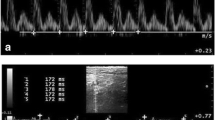Abstract
Objective.To clarify the relationship between blood pressure andpulse wave transit time at the peripheral artery from the R wave of theelectrocardiogram (m-PWTT), the effects of cardiovascular interventions onthis relationship was evaluated. Methods.Ten mongrel dogs wereanesthetized by isoflurane inhalation, and catheter tip pressure transducerswere inserted into the ascending aorta and at the bifurcation of abdominalaorta to measure central and peripheral pulse wave arrival. Pulse wave arrivalat the ascending aorta from the R wave represents pre-ejection period (PEP)and pulse wave arrival between the ascending aorta and bifurcation of aortarepresents pulse wave transit time (PWTT), thus m-PWTT = PEP + PWTT.Hypertension was induced by the continuous infusion of dobutamine andphenylephrine, and hypotension was induced by deepening isoflurane anesthesia,acute blood loss and nitroglycerine infusion. The relationship between timingcomponents (PWTT, PEP, and m-PWTT) and blood pressure was recorded andanalyzed by using the least squares method. Results.The relationshipbetween timing components (PWTT, PEP and, m-PWTT) and blood pressure wassignificant and highly correlated. When the change in blood pressure was dueto the myocardial contractility, such as after dobutamine infusion, therelationship between all timing components and blood pressure was consistentand negative. However, when the change in blood pressure was due to thevasoactive agents, such as phenylephrine, the relationship between timingcomponents and blood pressure was dependent on the reflex change in PEP.Conclusions.Change in m-PWTT is a good parameter to predict bloodpressure changes, although the absolute blood pressure value cannot beobtained.
Similar content being viewed by others
REFERENCES
Hardy HH, Collins RE. On the pressure-volume relationship in circulatory elements. Med Biol Eng Comput 1982; 29: 565–570
Dahn I, Jonson B, Nilsen R. Plethysmographic in vivo determinations of elastic properties of arteries in man. J Appl Physiol 1971; 28: 328–332
Schimmler W. Correlation between the pulse wave velocity in the aortic iliac vessel and age, sex and blood pressure. Angiology 1966; 17: 314–322
Learoyd BM, Tayler MG. Alterations with age in the visco-elastic properties of human arterial walls. Circ Res 1966; 18: 278–292
Simon AC, Levenson J, Bouthier J et al. Evidence of early degenerative changes in large arteries in human essential hypertension. Hypertension 1985; 7: 675–680
Farrar DJ, Bond MG, Sawyer JK et al. Pulse wave velocity and morphological changes associated with early atherosclerosis progression in the aortas of cynomolgus monkeys. Cardiovasc Res 1984; 18: 107–118
Hasegawa M, Nagao K, Kinoshita Y et al. Increased pulse wave velocity and shortened pulse wave transmission time in hypertension and aging. Cardiology 1997; 88: 147–151
Contrada RJ, Del Bo A, Levy L et al. Form and magnitude of beta-sympathetic and parasympathetic in£uence on pulse wave transit time. Psychophysiology 1995; 32: 329–334
Okada S, Ishii K, Hamada H et al. Relationship between cardiac autonomic neuropathy and diabetic microangio-pathies and macroangiopathy in patients with non-insulin-dependent diabetes mellitus. J Int Med Res 1996; 24: 92–98
McDonald DA, Regional pulse-wave velocity in the arterial tree. J Appl Physiol 1968; 24: 73–78
Nichols WW, McDonald DA. Wave-velocity in the proximal aorta. Med Biol Eng 1972; 10: 327–335
Greene ES Gerson JI., Arterial pulse wave velocity: A limited index of systemic vascular resistance during normotensive anesthesia in dogs. J Clin Monit 1985; 1: 219–226
Obrist PA, Light KC, McCubbin JA et al. Pulse transit time: Relationship to blood pressure and myocardial performance. Psychophysiology 1979; 16: 292–301
Geddes LA, Voelz MH, Babbs CF et al. Pulse transit Fig. 3. Simulated changes in vascular elasticity (Elasticity), pulse wave velocity (PWV), pulse wave transit time (PWTT) in relation to the blood (transmural) pressure change between 50 and 250 mmHg.The values are calculated from the physiological parameters by Hardy et al. [1]. 500 Journal of ClinicalMonitoring and Computing Vol 15 Nos 7–8 December 1999 time as an indicator of arterial blood pressure. Psycho-physiology 1981; 18: 71–74
Gribbin B, Steptoe A, Sleight P. Pulse wave velocity as a measure of blood pressure change. Psychophysiology 1976; 13: 86–90
Young CC, Mark JB, White W et al. Clinical evaluation of continuous noninvasive blood pressure monitoring: Accuracy and tracking capability. J Clin Monit 1995; 11: 245–252
Wippermann CF, Schranz D, Huth RG. Evaluation of the pulse wave arrival time as marker for blood pressure changes in critically ill infants and children. J Clin Monit 1995; 11: 324–328
Newlin DB. Relationship of pulse transmission times to pre-ejection period and blood pressure. Psychophysiology 1981; 18: 316–321
Seagard JL, Elegbe EO, Hop FA et al. Effects of isoflurane on the baroreceptor reflex. Anesthesiology 1983; 59: 511–20
Stevens WC, Cromwell TH, Halsey MJ et al.The cardiovascular effects of a new inhalation anesthetic, Forane, in human volunteers at constant arterial carbon dioxide tension. Anesthesiology 1971; 35: 8–16
Philbin DM and Lowenstein E. Lack of beta-adrenergic activity of isoflurane in the dog: A comparison of circulatory effects of halothane and iso£urane after propranolol administration. Br J Anaesth 1976; 48: 1165–1170
Ahmed SS, Levinson GE, Schwartz CJ et al. Systolic time intervals as measures of the contractile state of the left ventricular myocardium in man. Circulation 1972; 46: 559–571
Bramwell JC, Hill AV. The velocity of the pulse wave in man. Proc R Soc 1922; 42: 298–306
Steele JM. Interpretation of arterial elasticity from measurements of pulse wave velocity. I. Effects of pressure. Am Heart J 1937; 14: 452–465
Pruett JD, Bourland JD, Geddes lA. Measurement of pulse-wave velocity using a beat-sampling technique. Ann Biomed Eng 1988; 16: 341–347
Nye ER. The effect of blood pressure alteration on the pulse wave velocity in the brachial artery in man. Br Heart J 1964; 26: 261–265
Author information
Authors and Affiliations
Rights and permissions
About this article
Cite this article
Ochiai, R., Takeda, J., Hosaka, H. et al. The Relationship Between Modified Pulse Wave Transit Time and Cardiovascular Changes in Isoflurane Anesthetized Dogs. J Clin Monit Comput 15, 493–501 (1999). https://doi.org/10.1023/A:1009950731297
Issue Date:
DOI: https://doi.org/10.1023/A:1009950731297




